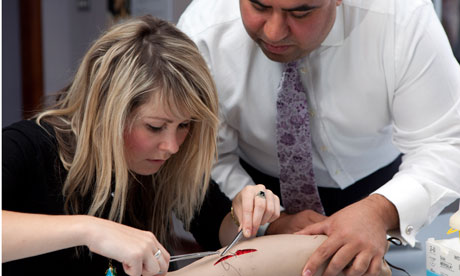
When I was 12 I went into hospital to have a lump removed and came out sporting a rather fancy set of stitches under my chin. I was pretty grumpy about looking like a mini- Frankenstein for a week – and never could figure out why I had two beads sticking from either end of the wound.
But this week I got the chance to find out, when surgeon Akan Emin offered to give me a masterclass in suturing or wound stitching. The lesson was ahead of All Stitched Up, an event at the Hunterian museum in London where medical professionals and knitters are being brought together to swap their stitching skills.
Having patched up jeans, darned socks and mastered all kinds of embroidery, I assumed I could have a good stab at stitching up a body. But when I was given a small, neat wound on a fake arm to practise on (made of red sponge and a sort of leatherette), not fainting is my first challenge. As someone who passes out during blood tests, I like to pretend there's a complex system of robotics inside us rather than admit we're packed with a squelchy, bloodied mess of organs and muscle.
Luckily, crafting served me well and instinctively I stick the needle into the fake arm at 90 degrees, close to the edge, but just far enough away so it won't rip – just as I would with fabric. The skin – albeit fake – is thick, and I have to push the needle much harder than I'd imagined; like sewing leather. "Skin is much thicker than most people realise," Emin explains. "But it's different on different parts of the body. The sole of a foot, that's very thick and callous, and harder to do than, say, an arm. The face is, of course, delicate, and very challenging, because it's so important it scars neatly."
The next problem is holding the needle. It's considered very bad form to use your hand – instead needles are manoeuvred using a holder and forceps. "It's more sterile," says Emin. "Plus, you can easily cut yourself if you're holding the needle in your fingers." With these new tools, I'm far clumsier than I thought I'd be and I squirm, thinking about what a slip of the forceps would mean had I been given free rein in A&E.
I've been handed a silk thread today – it's easy to use, and best for beginners – but for every wound or surgery there is a combination of threads, needle and stitches to suit. Sutures can be absorbable – left in to be broken down by the body; non-absorbable and taken out after a period of time; synthetic or non-synthetic; braided or non-braided. "Each material has a different property and glides through the tissue differently," says Emin.
Nylons, for example, are difficult to handle and hard to knot – but are routinely used for skin wounds as they slip out easily, and are less painful to remove. Polyesters are the standard for cardiac and vascular surgery, because they are non-absorbable and, unlike silk, don't react to moisture, fragment or lose their strength. If your sternum is being closed you can expect to come home with a stainless steel suture inside you, and if you need a bout of neurosurgery, braided silk will probably be the thread of choice.
Needles come in all shapes and sizes too: tiny, near-invisible ones are used in microsurgery, blunt ones stitch delicate, easily-damaged tissue such as the liver, and specialist needles that are super-sharp and spatula-shaped have been developed to make eye operations easier to perform. "There are no hard and fast rules though," says Emin. "We make decisions on a case-by-case basis."
As with crafty sewing, the method you use differs depending on the task in hand. There's interrupted stitches where the thread is cut and tied after each one, or continuous, where one piece does the whole job. Each has benefits – continuous is quicker, leaving fewer foreign bodies in the wound, but not as secure as infection can travel down the thread rather than being confined to one stitch.
Mattress is one variation Emin shows me. These stitches are made either side of the wound, then the thread is brought across it and either tied, or a second stitch made; it's used when tension needs to be minimised. Subcuticular is another, and it turns out to be the one used under my chin. The needle doesn't puncture the surface of the skin but the layer inside it, making scarring much neater.
But why the beads? Continuous subcuticular stitches can be tied to keep them secure, but some surgeons prefer threading beads on the end of the suture, which are held in place by little metal clamps. Although the stitches are surprisingly hard to master Emin tells me that in the past pig's bristles, kangaroo tendons and catgut were used. In South America, large ants were used to pinch wound edges together, their bodies being twisted off to leave their heads stuck to the patient. Suddenly those beads don't seem so bad.
•The lesson was ahead of All Stitched Up, an event at the Hunterian
museum in London (part of this weekend's nationwide Museums At Night
festival) where medical professionals and knitters are being brought
together to swap their stitching skills. Find out more at: culture24.org.uk/museumsatnight

